|
||||||||||||||||||||||
![Home - Air Power Australia Website [Click for more ...]](APA/APA-Title-Main.png) |
||||||||||||||||||||||
![Sukhoi PAK-FA and Flanker Index Page [Click for more ...]](APA/flanker.png) |
![F-35 Joint Strike Fighter Index Page [Click for more ...]](APA/jsf.png) |
![Weapons Technology Index Page [Click for more ...]](APA/weps.png) |
![News and Media Related Material Index Page [Click for more ...]](APA/media.png) |
|||||||||||||||||||
![Surface to Air Missile Systems / Integrated Air Defence Systems Index Page [Click for more ...]](APA/sams-iads.png) |
![Ballistic Missiles and Missile Defence Page [Click for more ...]](APA/msls-bmd.png) |
![Air Power and National Military Strategy Index Page [Click for more ...]](APA/strategy.png) |
![Military Aviation Historical Topics Index Page [Click for more ...]](APA/history.png)
|
![Intelligence, Surveillance and Reconnaissance and Network Centric Warfare Index Page [Click for more ...]](APA/isr-ncw.png) |
![Information Warfare / Operations and Electronic Warfare Index Page [Click for more ...]](APA/iw.png) |
![Systems and Basic Technology Index Page [Click for more ...]](APA/technology.png) |
![Related Links Index Page [Click for more ...]](APA/links.png) |
|||||||||||||||
![Homepage of Australia's First Online Journal Covering Air Power Issues (ISSN 1832-2433) [Click for more ...]](APA/apa-analyses.png) |
||||||||||||||||||||||
| Last Updated: Mon Jan 27 11:18:09 UTC 2014 | ||||||||||||||||||||||
|
||||||||||||||||||||||
|
||||||||||||||||||||||
![Home - Air Power Australia Website [Click for more ...]](APA/APA-Title-Main.png) |
||||||||||||||||||||||
![Sukhoi PAK-FA and Flanker Index Page [Click for more ...]](APA/flanker.png) |
![F-35 Joint Strike Fighter Index Page [Click for more ...]](APA/jsf.png) |
![Weapons Technology Index Page [Click for more ...]](APA/weps.png) |
![News and Media Related Material Index Page [Click for more ...]](APA/media.png) |
|||||||||||||||||||
![Surface to Air Missile Systems / Integrated Air Defence Systems Index Page [Click for more ...]](APA/sams-iads.png) |
![Ballistic Missiles and Missile Defence Page [Click for more ...]](APA/msls-bmd.png) |
![Air Power and National Military Strategy Index Page [Click for more ...]](APA/strategy.png) |
![Military Aviation Historical Topics Index Page [Click for more ...]](APA/history.png)
|
![Intelligence, Surveillance and Reconnaissance and Network Centric Warfare Index Page [Click for more ...]](APA/isr-ncw.png) |
![Information Warfare / Operations and Electronic Warfare Index Page [Click for more ...]](APA/iw.png) |
![Systems and Basic Technology Index Page [Click for more ...]](APA/technology.png) |
![Related Links Index Page [Click for more ...]](APA/links.png) |
|||||||||||||||
![Homepage of Australia's First Online Journal Covering Air Power Issues (ISSN 1832-2433) [Click for more ...]](APA/apa-analyses.png) |
||||||||||||||||||||||
| Last Updated: Mon Jan 27 11:18:09 UTC 2014 | ||||||||||||||||||||||
|
||||||||||||||||||||||
AH-64D Apache Longbow Flight Report |
by
Carlo
Kopp
First Published in Australian Aviation April 1999 Updated 2010, 2011 Text, Photography ©1999 - 2010 Carlo Kopp |
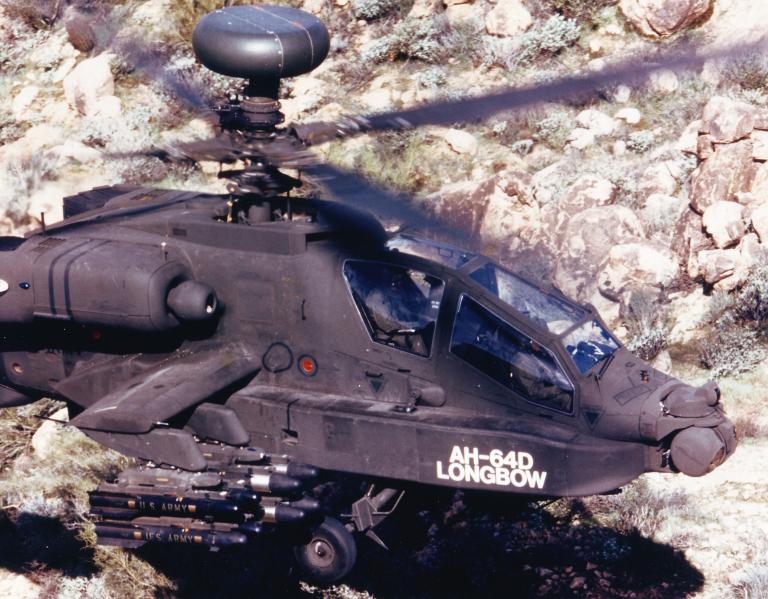 (Boeing
image)
The Boeing AH-64D Apache Longbow is without doubt the most sophisticated and capable of the contenders for the ADF's current reconnaissance and attack helicopterrequirement. Acquired by the US Army to provide the spearhead of its digitised battlefield forces, the AH-64D is now in delivery to the British Army and was recently ordered by the Netherlands Army. The capabilities of the digital Apache and its Longbow weapon system have no historical precedent on the battlefield, and truly herald the end of the main battle tank as a decisive land warfare asset. More over, the Longbow weapon system has also obsoleted the classical Soviet mobile battlefield IADS, and will displace the fixed wing Weasel in its role as the primary killer of battlefield air defences. At Boeing's invitation the author had the opportunity to fly in this remarkable aircraft and operate the Longbow weapon system. It was by any measure both a sobering and exciting experience, and has provided the author with much food for thought. The Hughes/MDC/Boeing AH-64A Apache The AH-64D is a direct evolution of the mature and combat proven AH-64A airframe and sensor/weapons package, with a number of far reaching and fundamental systems improvements. To best appreciate the significance of the AH-64D weapon system, it is useful to explore the basic rationale behind the AH-64A Apache, which is the baseline vehicle to which the digital D-model weapon system is added. The AH-64 was the outcome of the US Army's Advanced Attack Helicopter (AAH) program of the mid seventies, which saw the Hughes AH-64A chosen to replace the then incumbent AH-1 Cobra variants as the US Army's primary attack helicopter. The Cobra, a development of the UH-1 Huey airframe, was limited in survivability, load carrying ability, sensor capability and weapons capability, tied to the wire guided TOW missile system and optical LOS tracking guidance. The baseline AH-64A was revolutionary in its day, combining a very rugged yet high performance airframe, with substantial survivability features incorporated from the outset. Survivability comprises avoiding detection, and if detected and engaged, jamming the threat, if hit surviving the damage, and if shot down, walking away from the wreck. Acoustic signature was reduced against the AH-1 by using four bladed main and tail rotors, and inlet shrouds. The heat signature was significantly reduced by using a multiply ducted internally angled exhaust heat suppressor, designed to mix cold air into the exhaust and shield the turbine face. The arrangement is designed to further facilitate mixing of the cooled exhaust flow with rotor downwash. 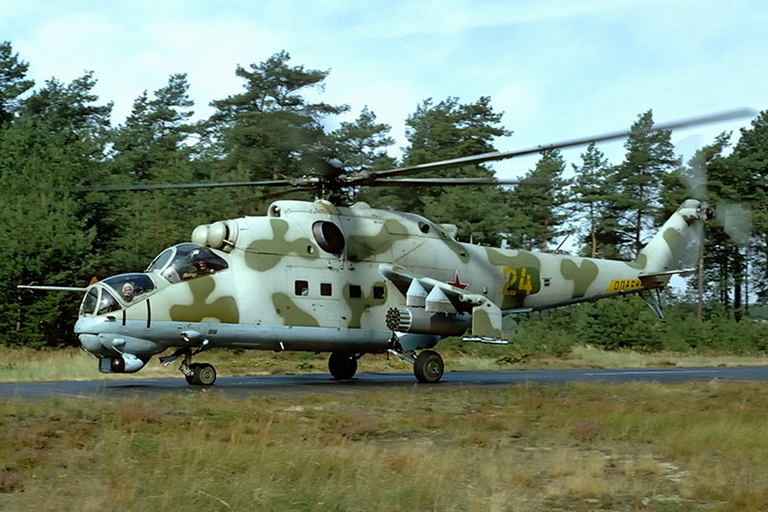 The Mi-24V Hind E was the Soviet
response to
evolving attack helicopter needs (© 2010, Jeroen
Oude
Wolbers).
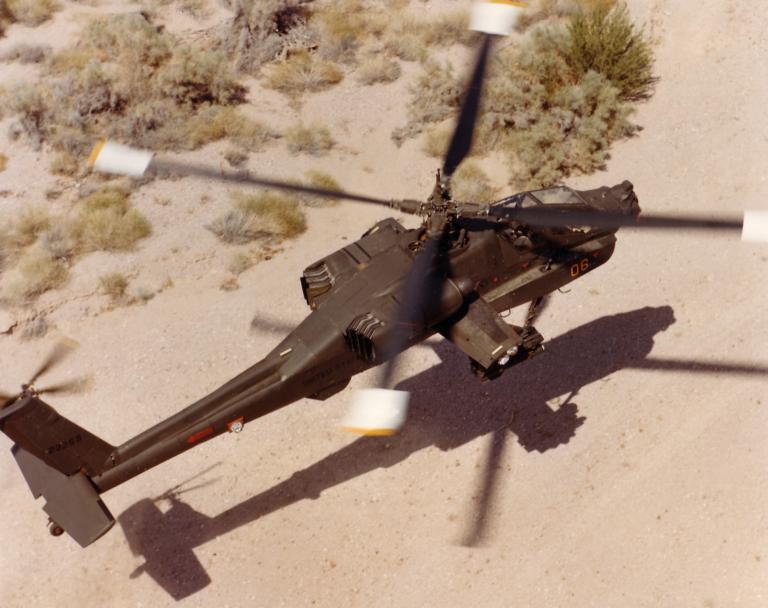 AH-64A
Apache
development
aircraft
(Hughes image)
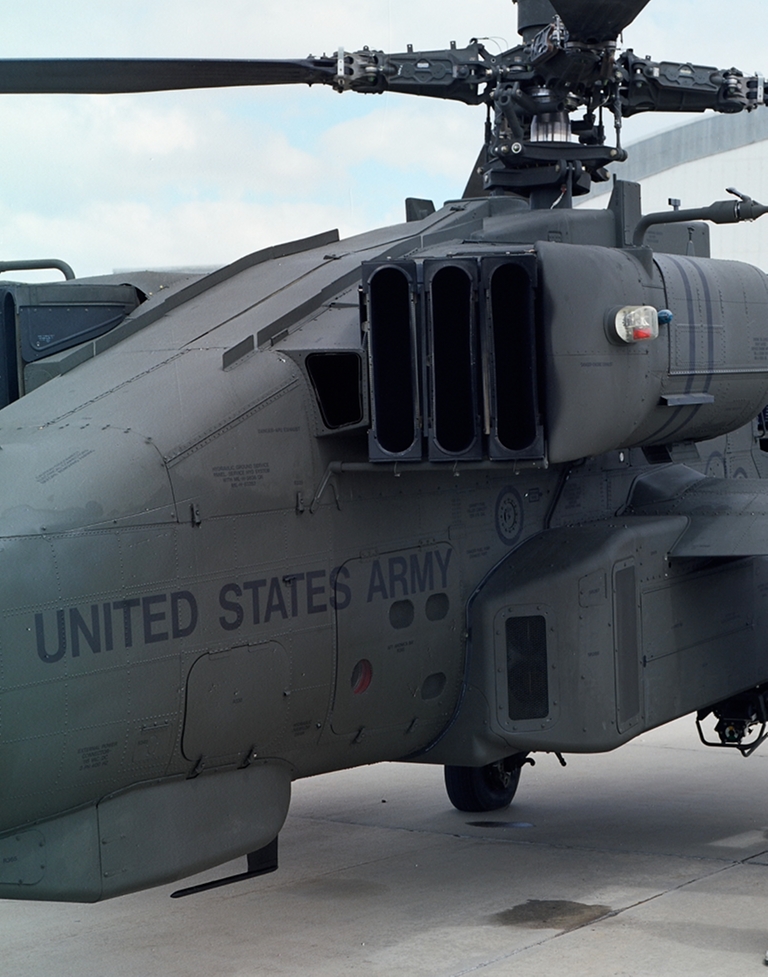 Grease filled gearboxes designed for substantial ballistic tolerance to 14.5 mm and 23 mm fire, twin T700 engines with sufficient reserve power to limp home on one powerplant, a tailshaft designed to absorb hits and if cut by fire, not to chop the tail off, extensive use of composite armour to absorb low calibre fire, shrapnel and spall, seat shock absorbers and structural design to absorb extremely high sink rates, a dual redundant 3000 psi hydraulic system and a host of other less evident design features provided the AH-64A with unprecedented damage tolerance. Unique aerodynamic and structural features included a Hughes patented fixed rotor mast, with a coaxial drive shaft, a single piece horizontal stabiliser driven by the flight controls for optimal fuselage angle and visibility over a range of flight regimes, a offset X tail rotor design to provide minimal tip vortex interference, hydraulically actuated weapon pylons to automatically provide the best station angle relative to the airframe for weapon launches. The weapon system of the AH-64A was also revolutionary in its day, freeing the helicopter from the tether of the wire guided TOW missile. The primary weapon of the new Apache was the semiactive laser homing AGM-114A Hellfire missile, designed to destroy AFVs up to the MBT, using its shaped charge warhead. Up to 16 rounds could be carried on four wing pylons. The weapon was targeted using the very new Martin Marietta AAQ-11 Target Acquisition and Designation System (TADS), a nose mounted and helmet steered turret combining a thermal imager, direct magnification telescope, a television camera and a laser rangefinder/designator. The pilot was provided with a helmet steered thermal imager. Both pilot and gunner were provided with the IHADSS collimated helmet mounted CRT projectors, designed to deliver raster scan camera imagery and calligraphic flight, weapon aiming and systems symbology directly into the right eye. The AH-64A was developed with the primary objective of providing an all weather day and night capable tank killing machine, to stop massive Warsaw Pact armoured offensives in the European theatre dead in their tracks, no pun intended. The combination of head steered weapon system and pilot night vision equipment provided an unprecedented ability to operate in Nap Of the Earth (NOE) flight at night. The CONOPS for the AH-64A was stealth by terrain masking, whereby the helicopters would hide behind terrain and approach their target, upon which they would pop up in hover above the terrain, only as high as required to detect, acquire and track their intended targets with the TADS system and engage them with salvoes of Hellfire missiles. Footage from the Desert Storm campaign showed classical examples of this tactic, with an AH-64 gunner firing off a sequence of Hellfires, seconds apart, then "walking" his laser from target to target as the missiles impacted. While tank and motorised infantry killing was the AH-64A's primary role, other capabilities were extant in the basic design. Suppressive fire support could be provided using up to four pods totalling 76 folding fin 2.75 inch rockets, and a ventral head steered M230 30 mm Hughes Chain Gun was available for self defence against other helicopters and SPAAGs, while also providing the ability to kill dismounted infantry, their supporting IFVs and APCs, and other soft skinned vehicles such as trucks and mobile command vehicles. In the almost quarter century since the AH-64A was conceived, the threat evolved accordingly. The baseline SPAAG of the day, the ZSU-23-4P, was superceded by designs with pulse Doppler clutter rejecting radars. Importantly, the shoulder launched SAM evolved from the cheap and nasty "shoot up the tailpipe" SA-7, to modern all aspect two colour seeker designs built to reject background and flares. Laser guided MANPADS have also proliferated, while laser rangefinders are now ubiquitous. MBTs can now shoot anti-helicopter fragmentation rounds, and most IFVs and APCs have rapid fire cannon. Thermal imaging sights are now commonplace on armour, and even a two bit helicopter may have NVGs onboard. The attack helicopter is today the "capital vehicle" of the land battle, having displaced the MBT into the niche role of close in mop up of dug in forces and heavy emplacements. This in turn has produced a situation where the value of the attack helicopter as a target easily justifies the launch of an expensive area defence Doppler radar guided SAM to kill it. The threat of the laser guided Hellfire spawned a new generation of battlefield smoke generators, dispensing clouds of infrared opaque particles. While these can often be penetrated by a thermal imager, they can often in sufficient concentration scatter the 1.066 micron band designator laser beam to the point of being unusable. The evolving environment saw the AH-64A progressively upgraded with the APR-39 Radar Warning Receiver, the ALQ-136 defensive jammer, the ALQ-144 infrared jammer and more recently, the AVR-2 laser warning receiver. In effect the AH-64A sprouted all of the avionic refinements of a mid seventies fighter aircraft. The 1991 Gulf campaign highlighted the strengths and the weaknesses of the AH-64A and its systems. The aircraft performed superbly in its primary tank killing role, and proved to be an exceptional tool for killing battlefield air defences. Of major importance was the famous radar killing sortie, in which a section of Apaches led by a USAF Pave Low III special operations helicopter penetrated undetected inside the Iraqi air defence perimeter and killed a key radar installation in the opening minutes of the air battle. Despite these successes, inclement weather, sand clouds and fog complicated operations by degrading thermal imager and laser performance. Long range night sorties under such conditions produced a very high workload for AH-64 crews, reducing their combat potential when contact was made with the enemy. Another problem found was situational awareness and early target acquisition, since the AH-64A would have to "unmask" in hover and sweep the battlefield with its thermal imager to locate targets. Even in wide FOV the TADS is a narrow FOV sensor, designed primary for acquiring targets and delivering weapons, in a "set piece" scenario. Long exposure times for target acquisition increase the odds of being sighted and engaged. The Digital AH-64D and the Longbow Weapon System The lessons of the Gulf War, and the evolving battlefield air defence threat, created the context in which the digital AH-64D Apache was conceived. The US Army aimed to achieve several objectives with the digital Apache:
The objectives were to reduce vehicle exposure, while increasing lethality and speed of engagement, the latter essential to disrupting an opponent's manoeuvre force and breaking up his cohesion at a tactical, operational and force level. Boeing, who acquired McDonnell Douglas (who earlier acquired Hughes Helicopters), set out to achieve this level of capability and survivability by a far reaching redesign of the Apaches weapon system. The core of the baseline D model weapon system is a highly integrated digital package, building upon the Mil-Std-1553B bussing technology of established "federated" architectures, but providing significant interlinking of onboard systems via software. Modern commercial 32-bit processors are employed. Experience from the F-15E crew station design was applied by engineers with prior involvement in that project, to provide a glass cockpit and "HOTAS" control interface in the new digital "MANPRINT" cockpit. The D model Apache is to other attack helicopters what the F/A-18A was to other fighters in 1978 - a wholly digital system which hides the vehicle and system complexities under a clean, synthetic interface provided by software. While the crew now see a revised cockpit with HOTAS controls, a pair of colour LCD menu driven displays and keypad, the capabilities hidden within the system run much deeper. All aircraft vital functions are monitored by software with extensive BIT support embedded. A dual RLG INS/GPS navigation system, supplemented by Doppler nav for accurate velocities, provides for extremely accurate navigation. An enhanced autopilot with attitude, altitude and position hold in hover takes the effort out of NOE "masked" hover behind covering terrain. The Improved Data Modem (IDM) is employed to datalink threat and target information between AH-64D in a unit, or to allow uplinking or downlinking of such data to other aircraft. A JSTARS, satellite, UAV or manned SAR/GMTI recce asset can provide the AH-64D with target sets via the IDM, or upload recce from the Apache. The datalinking facility is seamlessly integrated into the software, allowing the pilot or gunner to use mouselike screen click and drag operations to "segment" a target set and with a click of a button pass the targets to another AH-64D. Software provides the ability to fuse data from the aircraft's sensors, and to fuse offboard and onboard sources. Any weapon can be targeted by any sensor, and sensors may be slaved to other sensors. The weapon system is vastly more flexible than that in the AH-64A via the provision of Mil-Std-1760 "smart" digital station adaptors for all six wing stations. Any 1760 capable munition can be accommodated via a clearance test and software modification. Two Army ARC-201 FM radios are carried, and a ARC-164 Have Quick II frequency hopper is fitted, together with a ARC-186 VHF-AM radio. All may be accessed through the IDM under software control, to provide transparent digital access to other assets. This is baseline AH-64D Apache weapon system, common to all aircraft and the configuration for 3/4 of US Army deliveries, and all Netherlands deliveries. An optional fit to this baseline configuration is the Longbow weapon system, comprising the Northrop-Grumman (previously Westinghouse) AN/APG-78 Longbow mast mounted Fire Control Radar (FCR), and a Lockheed-Martin AN/APR-48 Radar Frequency Interferometer (RFI) package, both designed for all weather operation through precipitation and battlefield obscurants. The Longbow weapon system supports the AGM-114L active radar guided missile, operating in the same millimetric band as the radar. The Longbow radar is a very low peak power, millimetric band system, with extremely low sidelobes by virtue of a very large relative antenna size. The low emitted power, extremely narrow pencil beam mainlobe, and undisclosed LPI modulation features provide a system with a range of the order of 10 km in clear conditions, which is near to undetectable by established RWR technology. Only a highly sensitive channelised ESM receiver with a high gain antenna and low noise receivers can reliably detect such a signal, under optimal antenna pointing conditions. The choice of millimetric band means that atmospheric water vapour and oxygen resonance losses rapidly soak up the signal, which is also out of the frequency band coverage of most RWRs. The radar will track up to 128 targets and prioritise the top 16. The radar employs both real beam mapping and Moving Target Indicator (MTI) techniques, to provide the automatic detection, tracking and non-cooperative identification of surface targets, with a secondary capability against low flying aircraft. Target identification algorithms in the radar's software look at the shape of possible targets, and their Doppler signatures, to identify aircraft, helicopters, SPAAGs, SAM systems, tanks, AFVs, trucks and other wheeled vehicles. The capability exists to identify stationary targets through radar transparent camouflage netting and foliage. Real beam video and synthetic imagery can be displayed. The RFI is a multiple baseline, single plane wideband interferometer, with 360 degree coverage and increased resolution forward coverage, using a cluster of cavity backed spiral antennas mounted beneath the radar package. With significantly better detection range than the APR-39 and pointing accuracy better than a degree of arc, the RFI is essentially a compact ESM style passive targeting receiver which can precisely measure bearing to an emitter. This allows it to detect and engage a battlefield radar, SPAAG or SAM system typically from outside the threat's detection envelope, tracking the mainlobe or lower antenna sidelobes. The MilliMetric Wave Imaging (MMWI) L model Hellfire has inertial midcourse guidance, and uses its MMWI radar seeker to detect, acquire and home in on a targeted threat. The weapon can be fired LOBL off the rail, or for maximum range fired LOAL, with the launch aircraft masked behind terrain, flying out under inertial guidance to a preprogrammed footprint where the target is acquired. The Longbow weapon system is mounted on the rigid mast, and installation requires no avionic or software changes to the baseline D system. Once cables are hooked in and the computers booted, they detect the presence of the Longbow package and configure it into the weapon system. The highly integrated system provides fusion of radar, RFI, TADS and offboard targeting data into a single Tactical Situation Display format on one of the cockpit displays. The ability to slave sensors in an arbitrary manner, using HOTAS controls, allows the TADS visual ident of radar tracks, radar ident of RFI tracks, TADS visual ident of RFI tracks, or radar or RFI ident of camouflaged or obscured visual tracks. The radar can detect targets which cannot be seen behind radar transparent camouflage or foliage, noting that radar opaque camouflage nets effective against centimetric band fighter radars may not be very opaque in the millimetric band. Targets are automatically prioritised, with anti-air assets being accorded the highest priority, followed by armour and soft skinned vehicles. The mast mounted radar and RFI allow the Apache Longbow to remain masked behind terrain, only exposing the rotodome and RFI to detect targets. MMWI Hellfires can then be fired from a concealed location, with the pylon angles automatically adjusted by software to clear the rotor and terrain. An opponent will see the missiles pop up over the horizon and dive down to hit. Since the weapons are fire and forget, ie fully autonomous, once they are launched the helo can immediately move away to avoid "counter-battery" fire. The provision of a highly automated weapon system with basic sensor fusion is unique at this time to the Apache Longbow, and provides clearly unprecedented lethality in comparison with helicopters using only thermal imaging sights and laser guided missiles. Such systems are limited to engaging one target at a time, unlike the Apache Longbow which can engage many targets concurrently. The Apache Longbow's capability however extends further, since the IDM datalinking allows an Apache Longbow to hand off targets to non radar equipped AH-64D Apaches. In effect it becomes the notional equivalent of an AEW platform vectoring shooters on to targets. The US Army CONOPS is for a section of baseline AH-64Ds to be led by one or more Longbow equipped aircraft, which will provide wide area situational coverage of the battlefield for the remaining aircraft. The Longbow is the "hunter-killer" and the baseline AH-64Ds the "killers" in the "hunter-killer" package. This does not preclude the operation of sections wholly equipped with Longbow, or not equipped with Longbow. All aircraft can be fitted with the system, and all crews are trained to use it. The MMWI Hellfire can be carried by all aircraft, although it is most effective when supported by the Longbow. A textbook "ambush" scenario would see a Apache Longbow led AH-64D section move into position masked by terrain and coordinating via datalink. The lead ship would then raise its Longbow system to detect targets, and then drop back under cover, while the lead gunner distributes the targets via "drag and drop" to the other aircraft in the group, to avoid multiple targeting. At that point, all aircraft can salvo launch their MMWI Hellfires and back out into a new position, while the missiles attack the targets. The software "remembers" the coordinates of attacked targets and flags these on the screen with an X to avoid redundant reattack and wasting of rounds. Driving the Longbow Weapon System The author had the pleasure, at Boeing's invitation, to "test drive" the Longbow system at the February 1999 Avalon airshow outside Melbourne. Weather conditions on the day were clear, with high level overcast and moderate but slightly gusting wind conditions, and an ambient of about 32 degrees C. The author's pilot and "angel guardian" for the flight was Pete Nicholson, a Boeing Mesa production test pilot on the Apache Longbow program. The loadout was a pair of rocket pods outboard, two MMWI and two ALH Hellfires right inboard, and a drop tank left inboard. The missiles were training rounds with functional seekers. 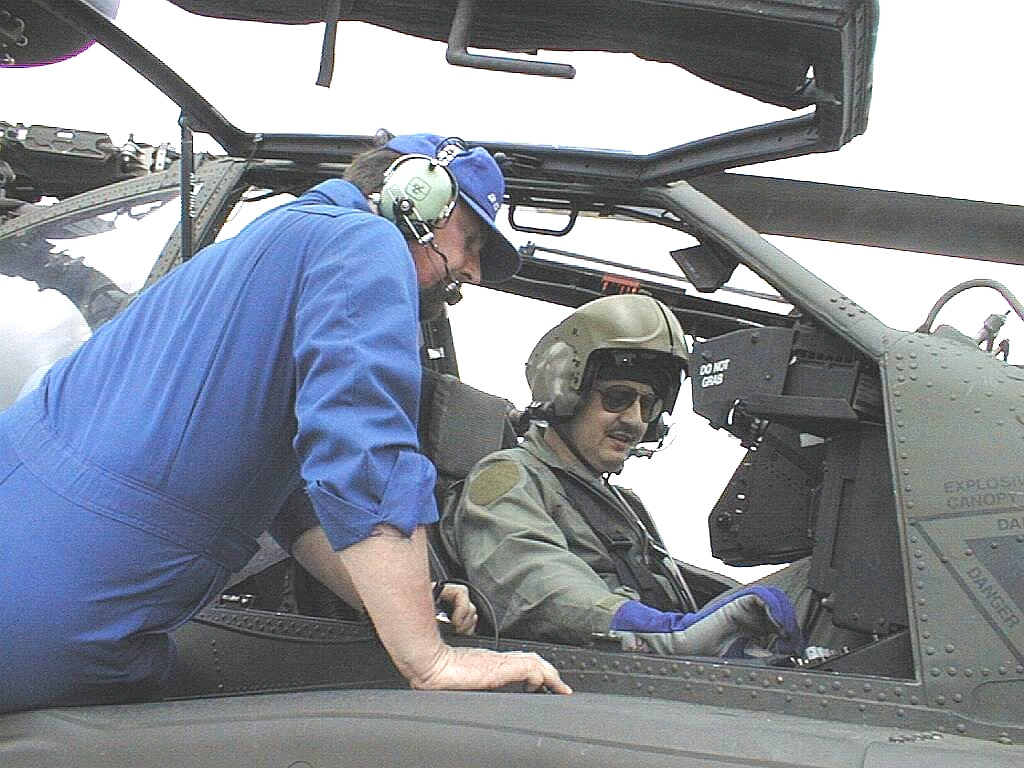 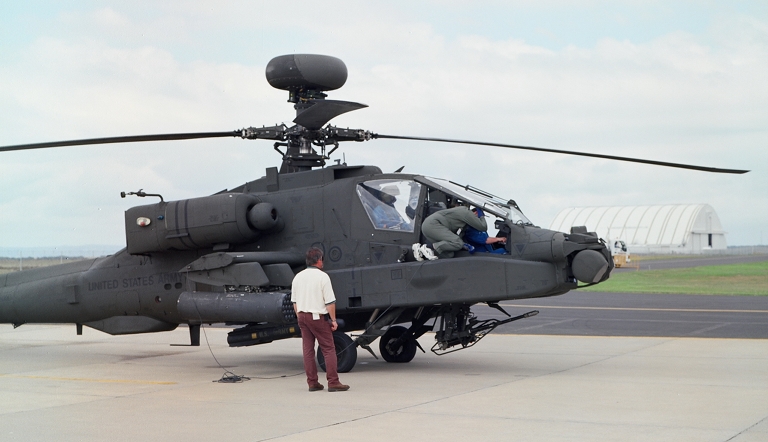 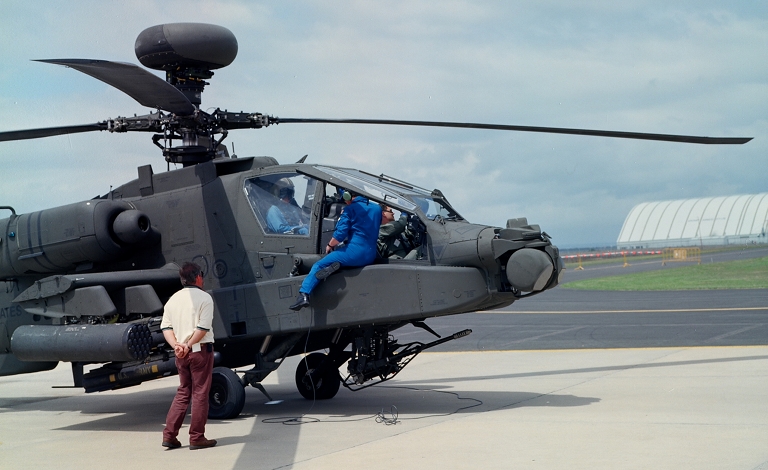  The flight was preceded by the customary helmet fitting, and then a brief cockpit familiarisation in the gunner/co-pilot station. Once the APU was up, the IMUs aligned and GPS acquired between 5 and 6 sats. A quick demonstration was given of the engine and systems status symbology on the MFDs, as well as BIT operation. Once the computers finished waggling the control actuators, Pete started the #1 engine and demonstrated on the display the symbology changes as he spooled the engine up to the redline. Once the #2 engine was started and the rotor up to speed we lifted off and headed out to our planned station in the foothills of the You Yangs, about 5 km from Avalon and 3-3.5 km from the Geelong Freeway. Cockpit noise levels were remarkably low for a helo. The aircraft accelerated smoothly and is a stable platform in the characteristically turbulent rural Australian low altitude atmosphere. Pete and his copilot had on the previous day test flown the aircraft and having picked a suitable "roost", locked it into the weapon system. We then flew directly to this station. Once on station, Pete slewed the aircraft to point at Avalon, and settled it into a hover at about 60 ft AGL. I was interested in seeing the performance of the automatic hover position, altitude and attitude hold, so Pete first demonstrated the attitude and altitude hold, which was very smooth but experienced slight wind drift as expected. Once the position hold was engaged, the aircraft remained firmly in place hovering OGE, with a slightly discernable rocking motion as the flight control system corrected for drift. The first phase of the demonstration saw Pete literally back seat navigate me through the HOTAS controls on the gunner's grips, and the basic Tactical Situation Display symbology which we set up on the left display, feeding the TADS into the right display. We brought the Longbow radar on line and executed the first sweep with real beam mapping active. We were still below the tree line and did not pick up any tracks. Pete applied a little collective and he popped up over the terrain high enough to see Avalon and the highway. Not good tactically since we were exposed, but desirable to demonstrate the TADS capability in conjunction with the Longbow. Prior to this flight I was a little sceptical of Boeing's claims of ease of operation, given how much I knew about the complexity of the underlying weapon system, which is comparable to that of a modern fighter aircraft. I was soon to be proven very wrong and can state that the vendor's claims are no overstatement, within minutes I could navigate my way through a number of menus and modes successfully. I cycled the Longbow through single and multiple radar sweeps. The radar detected the highway traffic, vehicles at the airfield, and taxiing aircraft, which appeared as yellow target type icons on the TSD within a second or so. The radar is "hot" only when the rocker switch is depressed, to minimise signature. The software prioritised the top two targets (hapless freeway commuters) with a diamond box over the first and triangle box over the second target, the boxes appearing almost immediately. The software automatically cued the MMWI Hellfires on the wing pylon to the these targets. I lifted the finger guard and squeezed off the first round. "Missile away" and we watched the countdown on the right hand display. The software reprioritised targets upon trigger depression, and marked the soon to be dead target with an X. In a tactical situation a gunner could loose off his weapons very quickly, without having to even worry about selection - all is performed by the software. The single sweep facility on the Longbow is excellent, properly coordinated crew operation allows a single mast exposure and sweep, to cover a 90 degree sector out to about 10 km. I played with the radar a little more under Pete's expert tutelage, and we then proceeded to a demonstration of missile seeker unlocking. Pete slewed the aircraft until the locked target was outside of the seeker's FOV. The software immediately marked the icon with black crosshatches to indicate that the missile was not longer able to acquire the target off the rail. The next demonstration was the TADS. Pete set up the system and I then engaged the TADS and using the right display, slewed it on to the Avalon flightline. A juicy C-130 in low contrast grey was a beckoning target, so I proceeded with an ALH Hellfire engagement. The TADS LOS is easily steered with the thumb pressure switch and the target was quickly acquired, tracked. "Missile away" and we watched the countdown. After missile "impact" I played a little with the TSD, under Pete's direction, exploring targets along the highway and the airfield, and picking out an obscured shack next to the treeline. The colour active matrix LCD is very sharp, contrast was excellent in bright diffuse ambient lighting, and response time to menu inputs instantaneous. The combination of automatic attitude stabilisation and TADS stabilisation provided a rock solid picture, and the TADS TV resolution was excellent. Within minutes I was able to calibrate to the picture and resolve targets. Boeing's statements concerning the ability of the Longbow to find targets hidden behind foliage is not an overstatement. The treeline along the freeway obscured much of the traffic, which could in some places not be seen through the TADS. The Longbow locked them up in a single sweep. The next demo was at my request the IHADSS flight symbology, which Pete piped into my left hand display since I did not have the IHADSS on my helmet. The setup process is a little time consuming, and since I wear corrective specs, not feasible for a demo flight. Having explored the Longbow and TADS, I asked Pete if we could try locking up a target on the RFI. We had line of sight to the city and I was hoping to lock up the Tullamarine primary or approach radars, or some hapless traffic cop with a K-band Gatsometer 24 or Kustom 10 along the freeway. The latter would be an enjoyable opportunity to try out the Longbow using the RFI to cue it on the emitter sightline. I selected the RFI on the TSD and Pete did a 360 degree sweep but we were unable to lock up any emitters. While the band coverage of the RFI was not been disclosed, the low band primary and approach radars would likely be out of band for the RFI antennas, which are clearly designed for G through K band operation, judging from their size. At this point time was running out, and whilst I could have easily enjoyed another hour hunting with the Longbow, alas this was not to be. We transited back to Avalon at about 100 AGL and 110 KIAS, again low level flight was very smooth. Upon returning to Avalon Pete demonstrated the TADS Flir and TV contrast adjustment, upon which time was up. Peter Ricketts was anxiously awaiting his turn, and sadly I had to part with the Apache Longbow. My overall impression from the demonstration flight is of an extremely flexible weapon system, with a well thought out and easy to use operator interface. The system software did not exhibit any notable bugs, lockups or crashes, as one might expect from a relatively immature embedded system of such complexity. The Longbow radar and MMWI Hellfire are an extremely effective package which should provide exceptional lethality when used by a tactically cunning operator. Combined with the TADS for target ID verification, even very restrictive RoE can be accommodated, albeit at some expense in exposure. The ability to cover an area approaching 80 square kilometres in a single 90 degree radar sweep has to be seen to be believed and clearly provides a quantum leap in capability over conventional optical attack helicopter targeting systems. The ease of use was remarkable for a system of such complexity, and I was comfortable with many aspects of the system within minutes of operation, and with no prior exposure other than two hours of reading brochures, briefing notes and a 1 hour preflight product brief. Boeing's Pete Nicholson provided a very professional demonstration flight, which complemented an excellent ground brief by Bob Mitchell, who is a retired US Army Colonel who has been flying attack helicopters since the early days in SEA. The Australian Context The US Army, British Army and Netherlands Army have all committed to the AH-64D as their primary battlefield attack helicopter, the latter in preference against two highly capable and by design newer European airframes. What convinced the British and Dutch to reject their European brethren ? There can be no doubt that the decisive factor was the digital weapon system, and in particular the Longbow radar/RFI/missile package. Given the incestuously political nature of EU defence procurement, the UK purchase of a fleet of fully Longbow fitted aircraft is an exceptional coup for Boeing. The ADF competition for a recce/attack helicopter has attracted a very wide field of bidders, the very modern European Tiger and Mangusta, a very modern variant of the venerable AH-1 Cobra, and "second tier" contenders such as the South African Redhawk and an armed variant of the UH-60. In terms of capability and survivability, none of the other contenders can match the Apache Longbow. The fundamental issue will therefore be one of cost vs capability. The Tiger and Mangusta are likely to be comparable in cost to the baseline AH-64D, without the Longbow, since they are dedicated new build designs of similar complexity, however to date not built in any numbers competitive with the huge base of the AH-64. The Cobra is likely to be cheaper, but is penalised by a first generation airframe structural design, albeit with a new engine and drivetrain design. The RedHawk is likely to be highly competitive in cost, and very rugged but basic in airframe design. The decision for the ADF will not be easy, in the current budgetary climate. Opting for the AH-64D, either fully, partially or optioned with the Longbow package will provide a very robust capability with plenty of long term growth and zero risk in support, given the 1000+ base of AH-64As and the US/UK commitments to the AH-64D. No doubt very tempting in many respects. However, it will be a costlier choice, especially up front, in comparison with the "second tier" bidders. From a strategic force structure perspective the AH-64D/Longbow would provide a capability in the wider region which would remained unchallenged for a very long time. The capabilities inherent in the Longbow package would to a considerable degree relax the demands for RAAF close air support and battlefield interdiction assets, a traditional bone of political contention between many members of the two services. It would also bias any future RAAF fighter capability requirements away from the encumbrances of the close air support and battlefield interdiction roles, in terms of needing larger numbers of modestly priced fighters with good close-in air-ground weapons packages. The RAAF's capabilities could be firmly focussed upon the strategic counter-air, strike and anti-shipping roles. Regional geography, be it along the Northern coastline, or in SEA, does not provide any potential opponent with any depth in the "land battlespace", therefore the "deep" battlefield interdiction role is not the issue it is in Europe, continental Asia, or the Middle East. Most potential targets would fall into the combat radius coverage of the Apache Longbow. Therefore, a force structure in which battlefield interdiction is primarily performed by a substantial force of Apache Longbow rotary wing aircraft could be argued to be a viable proposition. However, this would be at the expense of fixed wing fighter numbers, thereby compromising flexibility since multirole fixed wing fighters optimised for doing battlefield interdiction can also perform roles such as medium range anti-shipping strike and counter-air, roles which are not the forte of rotary wing aircraft. The problem is thus a little more complex than it would initially appear to be, especially in the context of a constrained budget. Should the close-in battle be favoured over the outer land-sea battle, in force structure terms ? Should the recce/attack helicopter requirement be coupled or decoupled from the wider air power force structure debate ? The fact that the Apache Longbow is comparable in many capabilities to fixed wing fighters, and intrudes into traditional fixed wing fighter roles, such as battlefield interdiction and SEAD/DEAD, makes this an extremely messy force structure problem. There are no simple answers. Our defence planners will indeed have a most interesting time deciding upon this requirement. |
|
|
|
|||||||||||||
![Sukhoi PAK-FA and Flanker Index Page [Click for more ...]](APA/flanker.png) |
![F-35 Joint Strike Fighter Index Page [Click for more ...]](APA/jsf.png) |
![Weapons Technology Index Page [Click for more ...]](APA/weps.png) |
![News and Media Related Material Index Page [Click for more ...]](APA/media.png) |
||||||||||
![Surface to Air Missile Systems / Integrated Air Defence Systems Index Page [Click for more ...]](APA/sams-iads.png) |
![Ballistic Missiles and Missile Defence Page [Click for more ...]](APA/msls-bmd.png) |
![Air Power and National Military Strategy Index Page [Click for more ...]](APA/strategy.png) |
![Military Aviation Historical Topics Index Page [Click for more ...]](APA/history.png)
|
![Information Warfare / Operations and Electronic Warfare Index Page [Click for more ...]](APA/iw.png) |
![Systems and Basic Technology Index Page [Click for more ...]](APA/technology.png) |
![Related Links Index Page [Click for more ...]](APA/links.png) |
|||||||
![Homepage of Australia's First Online Journal Covering Air Power Issues (ISSN 1832-2433) [Click for more ...]](APA/apa-analyses.png) |
|||||||||||||
| Artwork, graphic design, layout and text © 2004 - 2014 Carlo Kopp; Text © 2004 - 2014 Peter Goon; All rights reserved. Recommended browsers. Contact webmaster. Site navigation hints. Current hot topics. | |||||||||||||
|
Site Update
Status:
$Revision: 1.753 $
Site History: Notices
and
Updates / NLA Pandora Archive
|
|||||||||||||
|
|
Tweet | Follow @APA_Updates | |||||||||||
|
|
|||||||||||||
|
|
|||||||||||||